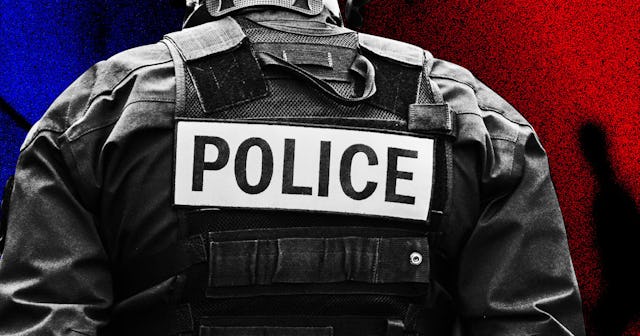Before You Say 'Not All Cops' Again, Look At The Historical Foundation Of America's Police Force

In the weeks since the death of George Floyd, the call for police reform has been taken up by the thousands of protestors who’ve marched through the streets demanding justice and change to a system that is irreparably broken. Opponents argue the police system itself is solid, and the issue is nothing but a few “bad apples” who’ve managed to escape detection.
But a deeper look into the history of America’s police force highlights just how inherently problematic our justice system and police force is. Since its inception, the United States police force has been shaped by economics and politics, and the changing definition of what it means to keep public order, as defined by those in power.
Said another way, since the very beginnings of policing the people in power get to define what is order and what is not, what is a policeable offense and what is simply allowed. When the people in power make the rules, the rules are often unfair. The starkest and most relevant example I can think of is the death of George Floyd for the alleged offense of using a counterfeit twenty dollar bill, compared to the ongoing slap-on-the-wrist, slow-burn investigation response to the allegation that United States senators abused their nonpublic knowledge to participate in insider trading, to the tune of hundreds of thousands of dollars, in the days before the economy would fall apart.
In an interview with NPR, Chenjerai Kumanyika, a researcher, journalist, and artist who works as an assistant professor in Rutgers University’s Department of Journalism and Media, summed it up like this: “[T]here’s far more evidence to support the view that modern policing was invented to make sure that that social hierarchy remained intact.”
Problematic Police Origins in the United States
I remember learning about how World War I started in history class, way back in high school. I remember learning about how the United States became a two party system. But I don’t remember learning about how the police force came to be.
As far as I knew, the police had always just been. A system developed long before history books and then carried over into modern day.
As it turns out, that’s not quite true. The United States police force is a relatively modern creation that’s been shaped by economics and politics and has been shaped by two intersecting narratives, both centered around what Kumanyika would call “labor control.”
In northern cities like Boston, modern policing emerged in 1838 at the shipyards, out of the need to protect property and secure goods as they moved from port to port. But that’s only part of the story. Police forces were also used by well-connected businessman and politicians to control anyone who might disrupt their version of law and order, including strikers, labor-union organizers, and waves of immigrants who looked and acted differently from the cities’ current population, and formed, arguably, the backbone of the workers. In essence, those in power found a way to control those without power under the guise of the common good.
Steve Skinner Photography/Getty
In the South, preservation of the slavery system drove the creation of modern day policing. Slave patrols, teams of white volunteers, were permitted to use vigilante-like tactics, including forcefully entering homes, in order to locate and return enslaved people and punish enslaved workers for violating plantation rules. When slavery was abolished, the slave patrols were dissolved, and the police force turned its attention to enforcing Jim Crow laws, which mandated separate spaces for Black people. But while those laws were being enforced, often violently, the judicial system was failing to hold the police accountable when Black people were murdered by mobs. The idea that Black people might be on the wrong side of the law simply for existing was born.
Evolution of the Police: Then and Now
The problematic origins didn’t disappear as we moved closer to the 21st century, and that’s never more obvious than when we look at the past and present side-by-side.
In 1929, the Illinois Association for Criminal Justice published a survey regarding data on police activity, which found that though African-Americans made up five percent of the population, they accounted for 30 percent of police killings. Nearly 100 years later, Mapping Police Violence found that Black people were nearly three times more likely to die from police than white people, and in 99 percent of the killings the officer is not charged with a crime. Side by side, the numbers look alarmingly close.
The photos comparing the Civil Rights Era protests of the 1960s are almost eerily similar to the photos splashed across social media every day. During the Civil Rights Era of the 1960s, peaceful protests for equal rights for Black people were often met with tear gas and other “[a]ggressive dispersion tactics, such as police dogs and fire hoses, against individuals in peaceful protests and sit-ins” by the police. The tactics haven’t changed. Peaceful protests in support of the Black Lives Matter movement have been with tear gas and other aggressive tactics that are caught, frequently, on camera.
Held up, the past beside the present, it’s almost frightening to see how little has changed in so many decades. Because the system is not simply marked by a “few bad apples.” It is instead damaged in its foundation–a foundation created to protect the status quo. And it is that foundation that needs to be inspected, understood, and repaired before change is possible.
Understanding the history of something helps give context. Understanding the problematic origins of the police system allows us to see how intricately threaded the problems inherent in the police system are, and why calls for reform have grown so loud. And mostly, reaching into the past and understanding the historical roots of a broken system allows us to maybe, hopefully, begin to find ways to build something better.
This article was originally published on